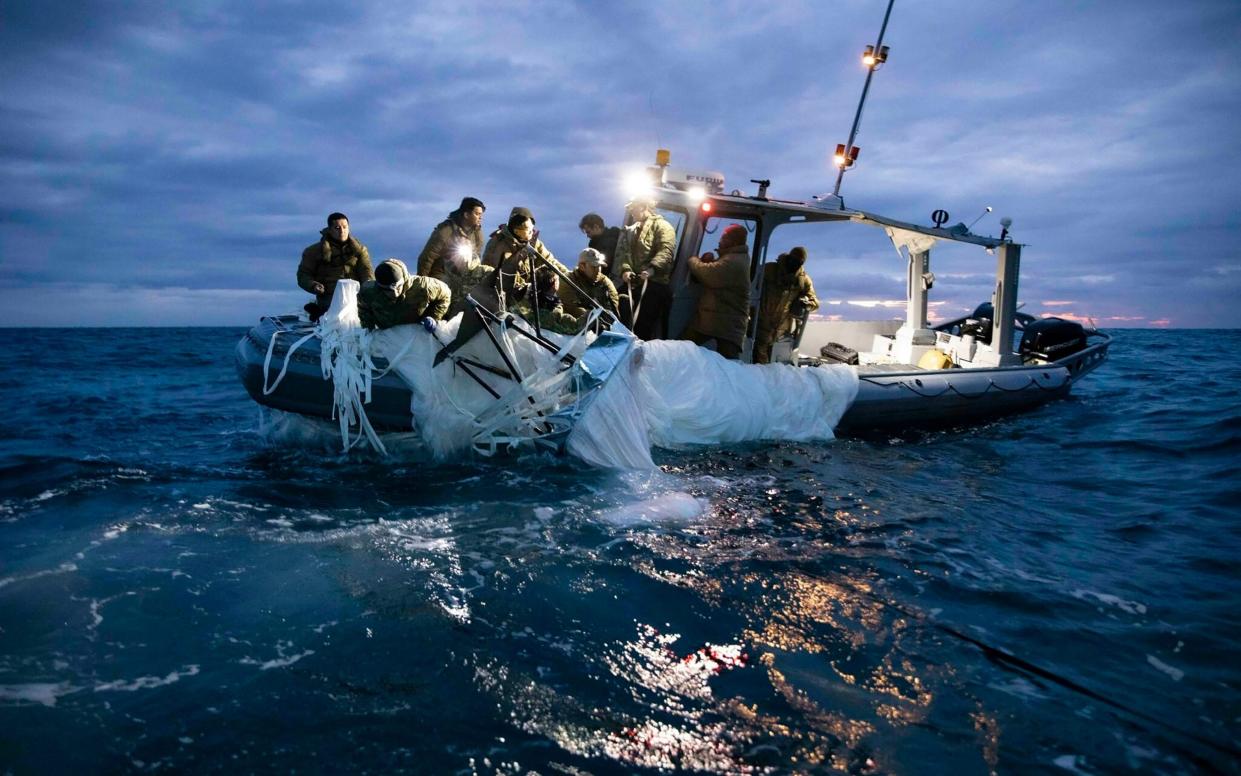Chinese spy balloon 'may have contained explosives'

The Chinese spy balloon may have been carrying explosives in a huge payload “the size of a jetliner”, a top Pentagon official revealed on Monday.
The satellite, which defence officials said on Monday weighed tens of thousands of pounds and was 200ft tall, may have had a built-in explosive self-destruct function.
A US Air Force F-22 fighter jet shot down the Chinese spy balloon off the South Carolina coast on Saturday, a week after it first entered US airspace and triggered a dramatic spying saga that worsened Sino-US relations.
The USS Carter Hall landing ship has collected the majority of the debris, the Pentagon said, while the military is using sonar to locate any parts that may have sunk.
The US navy has released an image of a surveillance balloon being retrieved in Myrtle Beach.
Mr Biden's Press Secretary Karine Jean-Pierre said on Monday night: “Shooting the balloon down over water wasn’t just the safest option, it maximized the chance of recovering the payload, giving us a better chance to get information from the Chinese surveillance balloon".
Air Force General Glen VanHerck, head of US North American Aerospace Defense Command and Northern Command, told reporters they had so far ascertained that the balloon had a payload the size of a regional jetliner, weighed "in excess of a couple thousand pounds", and potentially carried explosives "to detonate and destroy the balloon."
He said experts continued to assess the debris, which covered the size of 15 football fields, and could not yet confirm whether there were indeed explosives.
The U.S. Coast Guard said Monday it was imposing a temporary security zone in the waters off Surfside Beach, South Carolina in the area where the balloon was shot down.
The 10 nautical mile area security zone blocks vessels from entering without permission of the Coast Guard and is intended to protect the public "from potential hazards associated with physical objects."
The Pentagon also revealed that Chinese spy balloons had briefly flown over the US at least three times during President Donald Trump's administration and one previously under President Joe Biden.
Jake Sullivan, White House national security adviser, defended Mr Biden saying since the president took office, the US “enhanced our capacity to be able to detect things that the Trump administration was unable to detect."
General Glen VanHerck conceded on Monday that previous spy attempts had been missed.
"I will tell you that we did not detect those threats, and that's a domain awareness gap," he said.
He added that US intelligence determined the previous flights after the fact based on "additional means of collection" of intelligence without offering further details on whether that might be cyber espionage, telephone intercepts or human sources.
Second Chinese spy balloon
It came as China admitted launching a second observation balloon, which it said "accidentally strayed" over Latin America after being blown off course.
The latest balloon was spotted by US and Colombian officials after a similar alleged spy balloon was shot down on the order of Joe Biden, the American president.
China’s foreign ministry acknowledged on Monday morning that the balloon was Chinese.
“It has come to be understood that the relevant unmanned airship is from China,” said Mao Ning, a spokesman. The device “seriously deviated from its scheduled route and accidentally strayed over Latin America and the Caribbean”.
This is similar to what Beijing said previously of the first balloon discovered, which had hovered in Montana over a major US nuclear missile silo complex.
China has maintained that it was a weather research “airship” that had blown off course due to “force majeure”, denying US allegations that the balloon had served surveillance and espionage functions.
Over the weekend, US fighter jets shot the first balloon down over the Atlantic Ocean, prompting Beijing to mock Washington for “shooting a mosquito with a cannon”.
Chinese state media ridiculed the US for acting in an “impractical” way and wasting its resources.
“The US interception method that featured an advanced stealth fighter jet and fired a missile is too costly,” wrote the Global Times, a Communist Party mouthpiece.
“If more balloons, not necessarily from China, fly across the US, the US Air Force would be exhausted in intercepting them in this way.”
Russia backed China on Monday, with Sergei Ryabkov, the deputy foreign minister, saying he was “confident” Beijing was responding in a responsible manner after the balloon travelled into US airspace.
The Chinese government even dismissed the head of its national weather service in what seems to be an attempt to deflect blame and to give credence to its claim that it was a civilian vessel.
Despite Beijing’s protestations that the balloon had no intelligence or military function, a defence ministry spokesman said that it “sternly protests against this move and reserves rights to take necessary measures in dealing with similar situations”.
Chinese state media took the message one step further, saying the US had set a precedent for Chinese forces to shoot down foreign vessels entering its airspace.
China has long maintained that it can do whatever it wishes in its sovereign territory – by land, air and sea.
But what China defines as within its borders does not always match with international law and regulations - a point of contention that Western policymakers and experts have long worried might spark a greater conflict.
China has become more belligerent in how it interacts with the rest of the world, dubbed “wolf warrior” diplomacy, and does in practice react aggressively when the US sails military ships through waters that Beijing claims as its own.


